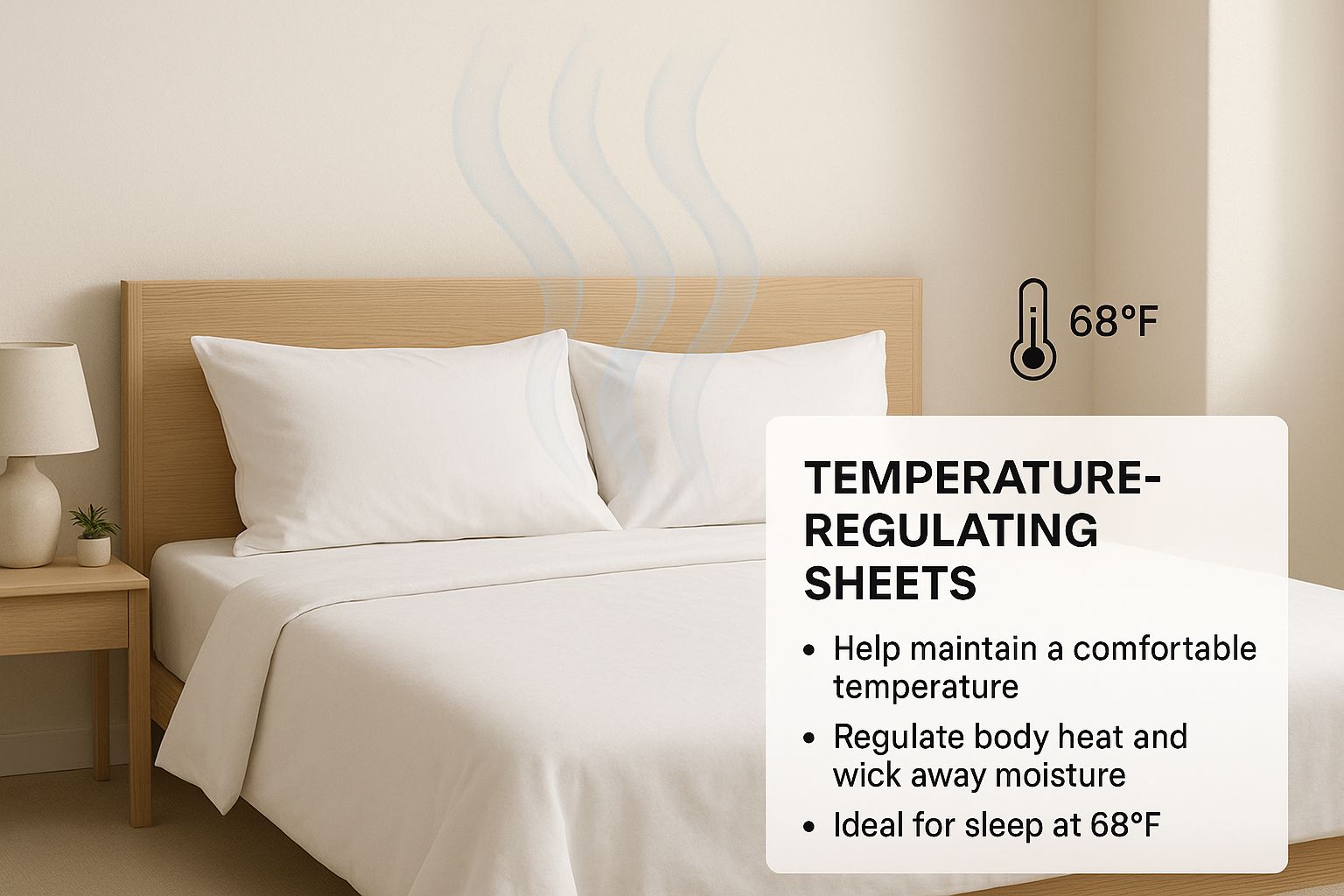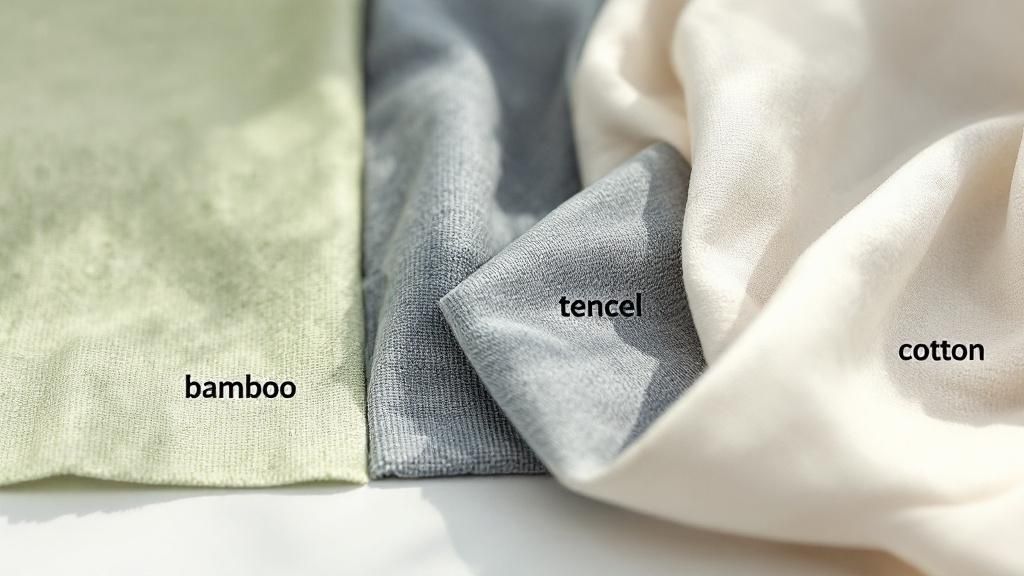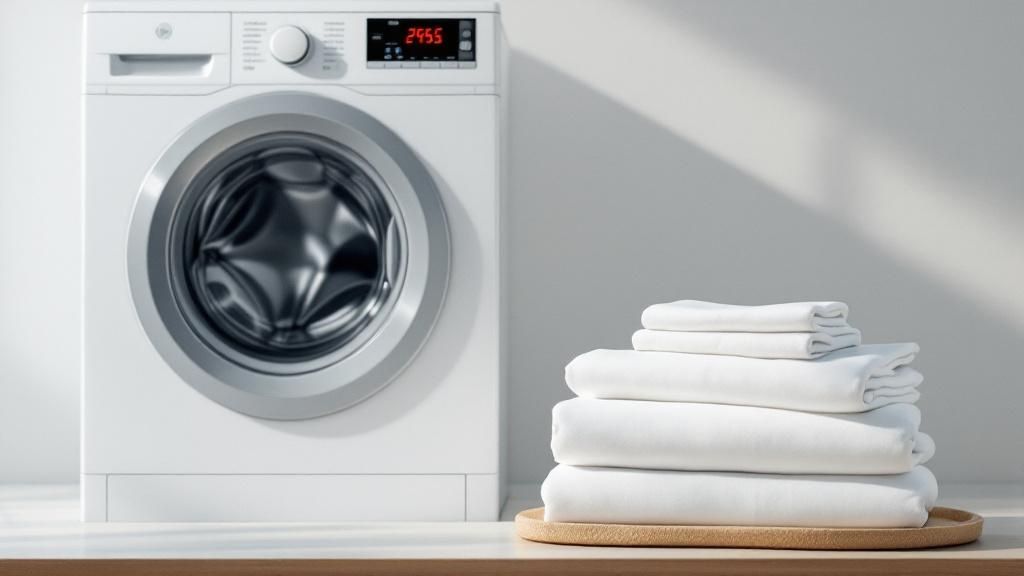If you're on the hunt for the best temperature-regulating sheets, you’ll find the top contenders are almost always made from bamboo viscose, Tencel™ lyocell, or linen. These fabrics are a game-changer, actively managing your body heat and wicking away moisture. For anyone who sleeps hot or deals with night sweats, they're a significant step up from traditional cotton.
Your Guide to a Cooler Night's Sleep
Ever find yourself kicking off the covers in the middle of the night? You're not just imagining things. Your body’s natural sleep cycle actually involves a slight drop in your core temperature. When your bedding traps the heat your body naturally releases, it creates a stuffy, humid little bubble around you, leading to sweating and a restless night. This is precisely where temperature-regulating sheets make a world of difference.
Unlike old-school materials that just insulate, these modern fabrics work with your body’s own thermoregulation process. It all comes down to two key features:
- Breathability: The structure of the fibers and the way the fabric is woven allows air to move freely. This prevents heat from getting trapped against your skin, letting that excess warmth escape naturally.
- Moisture-Wicking: These materials are pros at pulling sweat away from your body and spreading it across the fabric's surface, where it can evaporate in a flash. The result? You stay dry and avoid that dreaded clammy feeling.
The Science of Comfort
It's time to stop thinking of sheets as just a decorative layer. The right bedding is a powerful tool for getting deeper, more restorative sleep. By helping you maintain a stable and comfortable temperature, these sheets keep you from waking up in that endless cycle of overheating and then getting chilled. This is especially true for materials like bamboo, which is a fantastic choice for hot sleepers because of its inherent properties.
The core benefit is simple: temperature-regulating materials help preserve the ideal temperature your body is already trying to achieve for sleep. They don't force a temperature on you; they just help you maintain your own perfect balance.
This growing awareness around sleep quality has created a huge demand for performance bedding. The adult cooling sheet market, valued at around USD 1.2 billion in 2023, is expected to more than double, reaching a projected USD 2.4 billion by 2032. This surge shows a clear shift—more people are finally recognizing sleep as a fundamental pillar of health and wellbeing. You can dig into more insights about the adult cooling sheet market to see just how big this trend has become.
What Are the Best Materials for Keeping You Cool?
When you’re on the hunt for sheets that actually regulate temperature, the fabric you choose is everything. It's the single most important factor. While plenty of materials get marketed as "cooling," only a handful truly deliver. It all comes down to the natural properties of the fibers—how well they breathe, how they handle moisture, and how they feel against your skin.
Three materials consistently rise to the top of the list: Bamboo Viscose, Tencel™ Lyocell, and Linen. Each one offers a different experience, so the best one for you really depends on your personal preferences for feel, softness, and even the climate you live in. Let's dig into what makes each one a great choice.
This infographic gives a great visual breakdown of how these fabrics work to create a better sleep environment.

As you can see, it’s all about combining breathability with moisture-wicking to prevent that heat trap that so often ruins a good night's sleep.
Bamboo and Tencel: The Silky Smooth Options
People often talk about bamboo viscose and Tencel™ Lyocell in the same breath, and for good reason. They both have this incredibly soft, almost silky feel that drapes over you in a really luxurious way. Both are semi-synthetic rayons made from wood pulp—bamboo grass in one case, and eucalyptus trees for Tencel.
Their real magic lies in how they manage moisture. These fibers are fantastic at absorbing sweat and pulling it away from your body, much more so than old-school cotton. This moisture then evaporates quickly, which keeps you from feeling sticky and clammy.
- Bamboo Viscose: Famous for its buttery-soft texture. It's also naturally hypoallergenic, which is a huge plus if you have sensitive skin.
- Tencel™ Lyocell: Gets a lot of praise for its eco-friendly, closed-loop production process and its impressive durability. Many people find it feels even cooler to the touch than bamboo.
The bottom line is that both fabrics actively wick away moisture before it can make you feel hot and humid. They help your body maintain its ideal sleeping temperature without you having to kick off the covers.
Linen: The Crisp and Airy Classic
If you're not a fan of silky-smooth and prefer something a bit more textured and crisp, you can't go wrong with linen. Made from the fibers of the flax plant, linen has been a go-to for centuries, known for being incredibly durable and breathable. Its fibers are hollow and the weave is naturally loose, which allows for amazing airflow and lets body heat escape with ease.
Linen has a completely different feel from bamboo. It starts out with a distinct, slightly coarse texture that gets softer and more inviting with every single wash. It never clings, but instead rests lightly on your skin, making it a fantastic choice for anyone living in a hot, humid place where ventilation is key. Yes, it wrinkles, but that slightly rumpled look is part of its laid-back charm.
It's clear people are taking sleep quality more seriously. The global market for cooling sheets was valued at USD 1.8 billion in 2023 and is expected to nearly double to USD 3.5 billion by 2032. If you're interested in the numbers, you can dive into more details about the global cooling sheet market's growth and see just how big this trend is becoming.
Why Weave Matters More Than Thread Count

We've all been told the same story for years: the higher the thread count, the better the sheets. It’s one of the most stubborn myths in the bedding industry. While a sky-high thread count might sound luxurious, it's often the last thing a hot sleeper needs when searching for the best temperature regulating sheets.
The real secret to a cool night's sleep isn't about jamming more threads into a square inch of fabric. It's all about how those threads are woven together. The weave is what truly defines a sheet's breathability and how it feels against your skin, making it the most important factor for airflow.
The Percale and Sateen Showdown
When you're shopping, you’ll almost always run into two main players: percale and sateen. Knowing what sets them apart is your best tool for finding sheets that won't leave you sweating.
-
Percale Weave: Think of a simple, classic grid pattern—one thread over, one thread under. This straightforward construction gives percale its signature crisp, cool, and matte finish. More importantly, it creates a more open fabric structure that lets air move freely, wicking heat and moisture away from your body.
-
Sateen Weave: This weave is a bit more complex, typically using a pattern of three or four threads over, then one under. This technique creates that silky-smooth, almost shiny look that feels incredibly soft. The trade-off? That denser weave traps air, making it a much warmer option and less than ideal if you tend to overheat.
So, what does this mean in the real world? A 300-thread-count percale sheet will almost always feel cooler and more breathable than a 1,000-thread-count sateen sheet. The high thread count in sateen sounds impressive, but it’s achieved by packing fibers so tightly that there’s simply nowhere for your body heat to go.
A lower thread count in a breathable weave like percale is the key to cooler sleep. It’s a classic case of performance over numbers, proving that a denser fabric often works against your body’s natural cooling process.
Once you start focusing on the weave instead of just the thread count, you can shop with confidence. You’ll be able to spot the sheets that will actually deliver on their promise of cooling comfort. If you want to dive deeper into materials that work well with these weaves, check out the many reasons why bamboo sheets are an excellent choice for hot sleepers.
So, Which Sheets Are Right for Your Sleep Style?
Let's be real: there's no single "best" set of temperature-regulating sheets out there. The perfect sheets for your best friend might leave you miserable. Finding the right fit is all about looking at your own sleep habits, where you live, and maybe even the person sleeping next to you. It's this personal approach that makes all the difference.
First, get honest about your sleep problems. Are you someone who wakes up drenched in sweat night after night? Or do you just get a little too toasty every so often? Maybe you're constantly stealing the covers back from your partner who radiates heat like a personal furnace. Each of these scenarios points to a different solution.
Finding the Perfect Match for Your Bed
If you're a hot sleeper in a sticky, humid climate, the crisp, open weave of linen could be a game-changer. It’s all about maximizing airflow. But if you’re looking for a blend of cooling power and that silky-soft, luxurious feeling, you’ll probably find your sweet spot with Tencel or bamboo viscose.
Think about which of these situations sounds most like your bedroom:
- You frequently wake up with night sweats: Your top priority should be moisture-wicking. Materials like Tencel and bamboo are absolute rockstars at pulling moisture away from your skin so it can evaporate, keeping you drier and more comfortable.
- You and your partner have different internal thermostats: This is incredibly common. A breathable, mid-weight fabric like bamboo is often the perfect compromise. It won't trap the hot sleeper's body heat, but it still feels substantial enough to keep the colder sleeper feeling snug.
- You have sensitive or allergy-prone skin: Keep an eye out for third-party certifications. The OEKO-TEX® Standard 100 label is a great one to look for. It guarantees the fabric has been rigorously tested for a long list of harmful substances, making it a safer bet for your skin.
Think of it less like buying sheets and more like creating a personalized sleep environment. Your goal isn't just to find "cool" sheets, but to find the sheets that are just right for you, helping you maintain a balanced and comfy microclimate all night long.
This demand for personalized sleep solutions is really shaping the bedding market. In fact, just focusing on adult cooling sheets, the market was pegged at USD 295.63 million in 2024 and is expected to grow to USD 418.01 million by 2030. That growth is fueled by people like you who want more from their bedding than just a simple cover. If you're curious, you can dive deeper into these market trends in adult cooling sheets to see how innovation is rising to meet our sleep needs.
Caring for Your Sheets to Keep Them Cool

You've invested in the best temperature regulating sheets—that's a great first move. But making sure they stay cool for years to come all comes down to how you care for them. To protect delicate, high-performance fibers like bamboo and Tencel, your laundry routine really matters.
The best practice is simple: stick to a gentle, pH-neutral detergent and always wash in cold water. It might be tempting to use hot water for a "deeper clean," but it can actually weaken these specialized fibers over time, making them less soft and less effective at keeping you cool.
The One Mistake to Avoid
I've seen this happen time and time again: people ruin their expensive cooling sheets by using fabric softeners or traditional dryer sheets. They seem like a good idea, but these products work by coating fibers with a waxy film.
This residue clogs the fabric's microscopic pores, which is a disaster for breathability. It essentially suffocates the material, trapping heat and moisture instead of wicking it away. Before you know it, your cooling sheets just aren't cool anymore.
A much better alternative is to add a quarter-cup of white vinegar to the rinse cycle. It softens fabrics naturally without leaving any residue that gets in the way of performance.
The whole point of washing is to clean the fibers, not coat them. Skipping fabric softeners is the single most important thing you can do to protect the cooling technology woven into your sheets.
When it comes to drying, you have a couple of solid options:
- Tumble dry on a low heat or delicate setting. High heat is the sworn enemy of these fine fabrics and can cause damage that you just can't undo.
- Line dry whenever you can. This is by far the gentlest method. It preserves the integrity of the fibers perfectly and saves a little energy, too.
For more in-depth tips, especially if you have a specific material in mind, check out our complete guide on how to care for your bamboo sheets and keep them feeling like new.
Answering Your Questions About Temperature-Regulating Sheets
When you're diving into the world of performance bedding, it's natural to have a few questions. I hear the same ones come up time and again, so let's walk through them. This should give you the confidence to find the perfect set of temperature-regulating sheets for your bed.
A common point of confusion is whether these sheets will actively make you feel cold. The short answer is no. Think of them less like an air conditioner and more like a smart thermostat for your bed.
They’re designed to work with your body, not against it. By letting excess body heat dissipate and pulling moisture away from your skin, they help you stay in that sweet spot of thermal comfort all night long.
Can They Really Work for Both Hot and Cold Sleepers?
Absolutely, and this is where they truly shine. It might seem counterintuitive, but their exceptional breathability is the key.
- For the hot sleeper: That same breathability prevents heat from getting trapped, which is the primary cause of night sweats and overheating.
- For the cold sleeper: These materials provide just enough insulation to keep you cozy, but they won't make you feel clammy or stuffy because they still allow air to circulate.
This makes them a fantastic compromise for couples who can never agree on the bedroom temperature. It’s all about creating a balanced, personal microclimate under the covers where both people can sleep soundly.
The Bottom Line: Temperature-regulating sheets don't create an artificial temperature. Instead, they foster a breathable environment that helps your body maintain its own ideal temperature, whether you naturally run hot or cold.
I also get asked about thread count all the time. With cooling sheets, a higher number isn't just unnecessary—it can actually work against you. A dense, high-thread-count sateen weave, for example, will trap far more heat than a crisp, airy percale with a lower thread count. When it comes to staying cool, always prioritize the material and weave over the thread count.
Ready to stop fighting with your thermostat and start getting better sleep? Check out the 100% organic bamboo bedding collection at Bamtek and feel the difference for yourself. Explore our sheets today!










